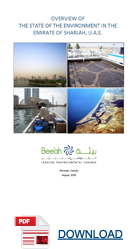State of the Environment in the Emirate of Sharjah, UAE Report
 Bee’ah conducted an environmental review and assessment on the Emirate of Sharjah. The on-site visits were made in October and November 2008 and the report was finalized in August, 2009. The main findings of this report were:
Bee’ah conducted an environmental review and assessment on the Emirate of Sharjah. The on-site visits were made in October and November 2008 and the report was finalized in August, 2009. The main findings of this report were:Air Quality and Atmospheric Pollution
There is a natural occurrence of suspended particulates which causes urban haze. Air pollution originates mainly from industrial activities, urban traffic and landfill sites. There is no air quality monitoring present, therefore there is no ambient conditions available.
Landfills
Unsorted waste is brought into landfills and annually there is approximately 1 million tons of waste is produced. Winds blow trash and dust into the air which causes nuisance to the workers and surrounding communities.
Waste Waters
There are five waste water treatment plants (wwtp) present in Sharjah Municipality, Al Dhaid, Kalba, Khor Fakkan and Dibba Al Hisn. The Sharjah Municipality plant is receiving 10,000m3 more than its daily capacity, i.e. they receive 165,000 m3. Plants monitor their own outputs in an onsite laboratory. Most of the treated water is used for irrigation (60-70%) while the rest is discharged into the sea. No standards are followed for this treated waste water.
Sharjah Lagoons
There are three main lagoons in: Al Khalid, Al Khan and Al Mamzar. Al Khalid lagoon is the most polluted lagoon due to over-fertilization and solid waste. Al Qasba Canal was made to improve the water quality via flushing between the Al Khalid and Al Khan lagoons, although little improvement has been seen.
Water Resources
The only source of water is the sea and salt water lagoons. The estimated freshwater production value in 2007 was 86.7 million gallons, of which about 70% was made through desalination practices.
Coastal and Marine Resources
The presence of construction and developments has caused dramatic changes to water quality and the water currents of the emirate. Over fishing and coral reef destruction are of key issues related to marine resources.
Marine Pollution
There are three important shipping areas are Port Khalid, Hamriyah Deep Water Port and Khor Fakkan Port. Oil pollution and other waste produced by boats located in these areas pose a serious threat to water quality.
Biodiversity and Habitats
There are four reserve areas in the emirate of Sharjah: Sir Abu Nu’air Island, Khor Kalba Mangrove, the enclave of Al-Zulaiyma and Seeh Al-Masmoot. The Al Wasit Nature Reserve is currently being remediated to a protected area. The Kalba mangrove forest ecosystem is being threatened with human encroachment into the area and erosion of the land.
Environmental Management and Governance
Federal law No. 24 of 1999 is the law responsible for the protection of the environment. The Environment and Protected Areas Authority (EPAA) is responsible for all environmental affairs in Sharjah, but do not conduct environmental monitoring or management. Sharjah municipality deals with solid and liquid waste issues of the emirate. Sharjah seems to have no unified approach to environmental management.
To read more download the PDF.
You can return to the main Market News page, or press the Back button on your browser.

